|
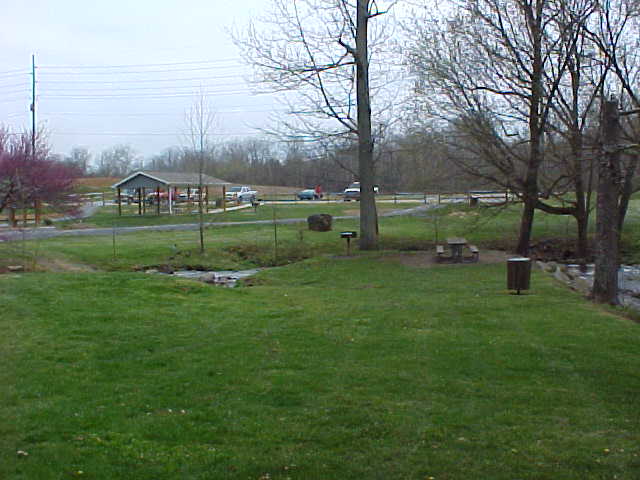
|
| a view of Rooster Front Park |
Tucked away off a narrow winding road in Bristol, Sullivan County, Tenn. is a little known forested Park
named Rooster Front. Actually the small Park is but the backdoor to the largest city park in the region:, ie...- Steeles
Creek Park. But , over 200 years ago, this little tract of ground with its merging streams, limestone outcroppings,
and steep wooded ridges & hollows, would have a very prominent place in the future history & establishment of
Bristol, Tenn-Va., as well as close ties with the future city of Kingsport, Tenn.
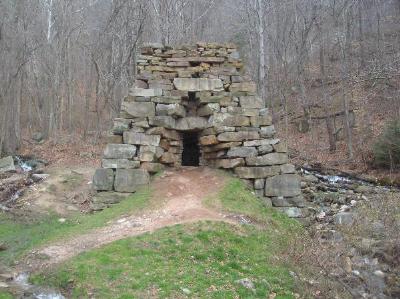
|
| Iron Furnace at Cumberland Gap |
It was upon the current Rooster Front Park property that Colonel James
King had established the first Iron Works in the State of Tennessee in 1784, (one source notes "possibly" 1788,
but I concur with 1784 ). The Iron Works were "located" , at the mouth of Steeles Creek. In
1790, Governor Blount became associated with Col. King's iron works and a dedication was held. Blount's wife broke a
bottle of rum upon the furnace and christened the furnace,"Barbara."
** Actually I believe this dedication was of King's 2nd Furnace, located one mile downstream Beaver Creek from the
first. Besides the conflicting dates, [1784, 1788, & 1790 above], a letter is extant dated May 12, 1806 from Col.James
King in which he gives his address as Beaver Creek Iron Works, Sullivan County,Tenn. Combined with the listings noted below,
it appears to indicate a second furnace was in operation. This 2nd furnace would have been near Phillipswood Dr., thus closer
to King's homestead.
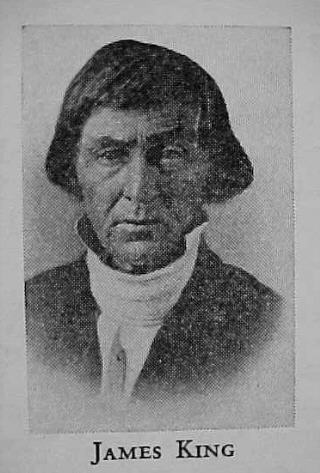
|
| Colonel James King |
ref:.... Thomas W. Preston, in his "Historical Sketches
of the Holston Valleys, " amplifies this statement with a brief sketch of the activities of Col. James King, in which
he says: "James King, after whom Kingsport was named, the first of the name to seek his fortune in America, was born in London
in 1752. He first settled in Montgomery County, Virginia, but was attracted by accounts of the beautiful and fertile valleys
of the Holston. He moved to Sullivan County, Tennessee, probably prior to 1774, and built a mill at the mouth of Reedy Creek,
which was known as King's Mill. He served in the Point Pleasant campaign in Captain Pauling's company of Botetourt troops.
He also served in a number of battles during the Revolutionary War and was wounded at Guilford Courthouse. He recovered from
his wound and was present at the surrender of Corn wallis at Yorktown. He was an ardent patriot, a man of considerable initiative,
and rendered valiant service to the colonies. In 1784 he built an iron furnace at the mouth of Steele's Creek in Sullivan
County. This was the first iron furnace erected in the state of Tennessee."
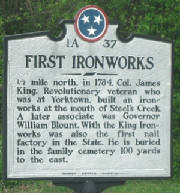
The Iron Works operated numerous years, but an exact number
is not known. Several sources, (Col. Sam L. King in 1914 for one), note the Iron Works provided cannon and cannonballs for
the War of 1812. Other sources state that after Col. King's death in 1825, George Bushong purchased it **, and kept it
operating another 25 years. This takes us up to about 1850 or so. BUT, if this is the case, why then did George Bushong erect
a furnace in 1837 on Little Sinking Creek, (Amanda), run it for one blast, tear it down, and subsequently rebuild it
, ( naming it Franklin), on Big Sinking Creek in 1838??? This furnace was documented as still being
in operation in 1859, whereas King's Iron Works is not noted.
** in one book it is noted that George Bushong purchased the King
Iron Works in 1833. Was the Iron Works then idle from 1825 to 1833?
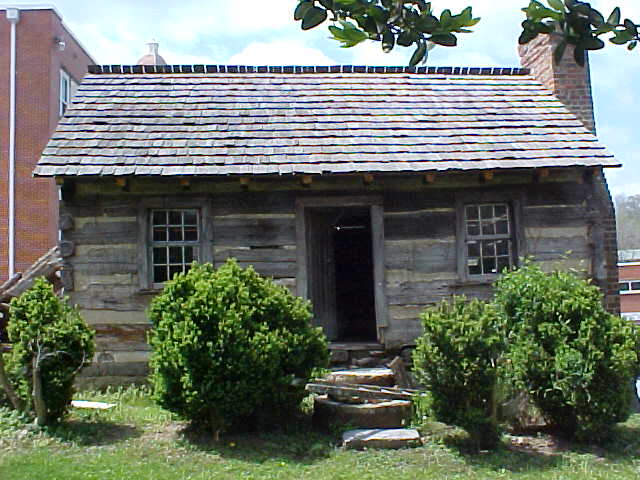
|
| Col. Kings log cabin at Deery Inn |
The King homeplace, named Holly Bend, was a short distance just downstream
on Beaver Greek & off present day Phillippswood Dr., but Col. King maintained a log cabin for use an
an office on property across the road from current Rooster Front Park, & where the Bristol Wasterwater Treatment
plant was once located.
** another source notes the log cabin as being first ,on the current Rooster Front Park
property, then was moved across the road at some point and to where the sewer plant would later locate.
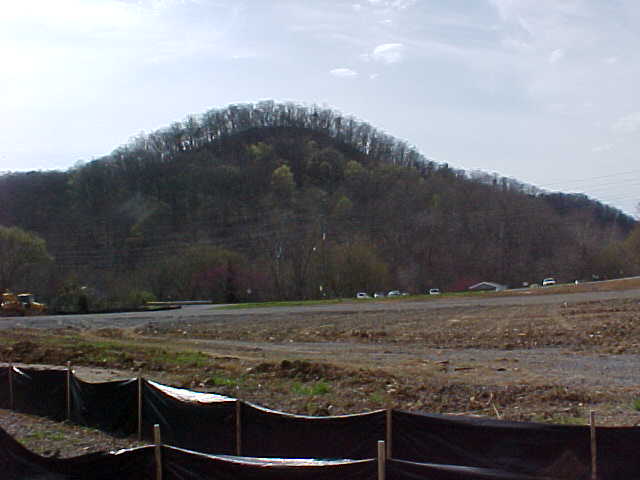
This property is currently in the process of being integrated into the Park. In the early 1950s
King's log cabin was purchased by Judge Caldwell & his wife of nearby Blountville, owners of the Deery Inn, transported
to the Inn, and restored. It sits there yet today, in a row of similar cabins also purchased and relocated by the Caldwells
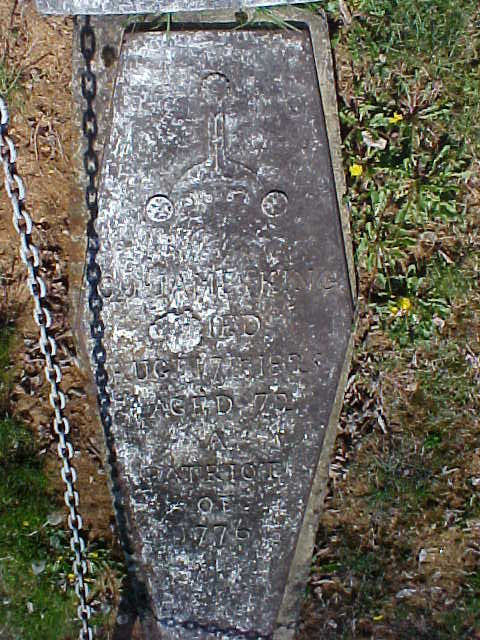
|
| Iron Slab Marker on Col. King's Grave |
My interest in the Iron Works came about due to my hobby of collecting & researching local antique
bottles & a general curiosity about other historical artifacts. I have roamed the former King plantation site , the Ordway
Cemetery where King lies buried with his wife, and the environs of both Rooster Front & Steeles Creek in pursuit
of some signs of foundations, pottery, ironware, bottles...anything I could tie to King. Due to many varied construction
and demolition projects in the ensuing years , my search has been fruitless. In the process of this endeavor, and researching
about same, I learned a lot about that area, some of which is known and some of which is little known, if known at all.
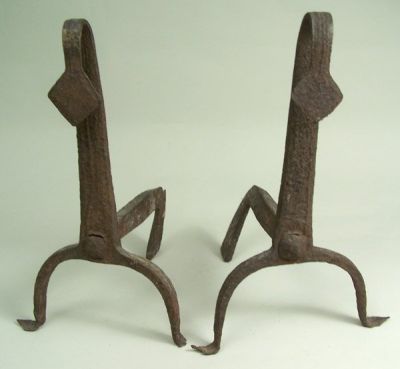
|
| Andirons reportedly made at Kings Iron Works |
For instance. I had envisioned a simple iron works involving some type of furnace. Little did I know
it was much more extensive than that. The first hint was the fact that one John Burnett who was involved with the Cherokee
removal in 1838, ie .."the Trail of Tears", gives his birthplace as Kings Iron Works, Sullivan
County, TN.
A second "hint" was the fact that Sarah Goodson King, wife
of Col. James King is noted as having died in 1806 at King's Iron Works.
A third "hint" is given in the text of court testimony about
a two letters -dated 21 April 1797, written by William Blount at the mouth of Steeles Creek in Sullivan County, with a return
address of Colonel Kings Iron Works.
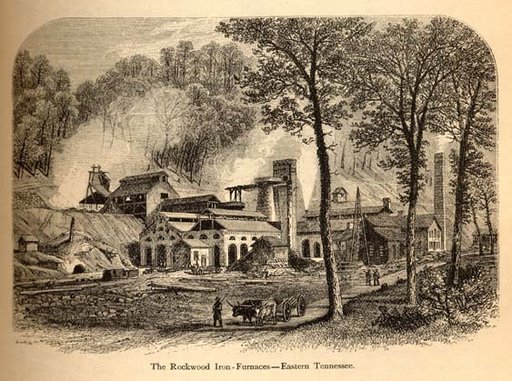
|
| Rockwood, TN. Iron Works in 1867 |
This indicated to me that some type of "community" grew up around the Iron Works. More
research taught me that in about 1867, one iron works in Georgia had over 500 people associated with its operations.
Besides the furnace moulders, "blacksmiths", and forgers, there were lumbermen who cut & trimmed the trees, draymen who
hauled the logs to the furnace staging area, men who made the charcoal from the logs, men who loaded the furnace with
the raw ore and with fuel,men who quarried the limestone , men who mined the raw ore, men who oversaw operation
of the bellows and waterwheel, people who farmed the nearby fields to produce food for the workers and their families, men
who drove the wagons to & from Kings Port and , to & from the ore banks, men who delivered supplies, salesmen
for the products that were made from the iron, overseers to insure all work went smoothly and as planned, and a
host of other individuals affiliated with the workings of the furnace community.
I also learned that it was entirely possible King obtained his iron ore more locally than Orebank, TN.,
located about 25 miles away , and when considering wagons were the sole means of transportation on rutted, winding, often
muddy, dirt roads through dangerous territory ( Indians & animals), , it seemed obvious to me that an orebank had
to be closer. And indeed they were....Sharp's, Crockett's, Cowan's, and Thomas' , located in the Holston Valley region
of Sullivan County were but half the distance, or even less. [ http://www.mindat.org/loc-130384.html] When these Holston Valley orebanks were discovered and opened is not known by me. But they were being used by George
Bushong at the Amanda Charcoal Furnace as early as 1837. There is additional evidence Bushong had been using Sharp's
orebank much earlier: as on the 23rd of June 1835, there is documentation indicating he was pursueing the purchase
of same.
According to published texts dated 1884, the Crockett Bank had been opened 75 years
earlier...ie...about 1807.
While it is true Orebank owes its name due to the presence and mining of iron ores,
and that King owned a large portion of it , ( having sold 5 acres of same to David Ross in 1793), it couldn't have been where
he was getting his raw ore for the Steeles Creek Iron Works. It wasn't practical.
In my research to question the viability of King's ores all being mined
at Orebank,shipped 25 miles to be processed and then being sent back down that same road and on beyond to Kings Port to be
shipped down the Holston River by flatboat, I learned some interesting facts about early iron works. Before a furnace
was even constructed an area was located that had to have the following attributes:
1) trees for wood to make charcoal to fire the furnace and to construct buildings & cabins for workers.
2) a reliable water supply for power to the waterwheel and to aid in cooling
3) limestone in quantity was necessary as a flux in the extracting of ore from the shale or ore-bearing rocks, and to
build the furnace , forge and any other required structures, (ie...cabin foundations , chimneys, an additional furnace).
4) a semi-level hillside upon which to build a "bridge" to the furnace mouth.
5) iron ore in quantity
The 3 most important requirements were: an orebank , a constant water source,
and a flux ( limestone) source - all had to be close to the furnace. If necessary the furnace could
be dug into the side of a hill in order for a "bridge" to be built. And, lightweight charcoal made from trees/wood, could
easily be hauled. Much more so than the limestone or ore bearing rocks.
I feel I have located the highwall of the limestone quarry used by King within the environs of
Rooster Front Park and the possible, or plausible , site of at least one furnace at the mouth of Steeles Creek. Mr.
Jeremy Stout ,a Geologist and the Manager of Steeles Creek Park & Nature Center, has stated that it certainly looks like
one, but was waiting till winter to give it a more thorough examination. Mr. Joe Lee III, an amateur rockhound and researcher,
who has worked in quarries in SW Va. believes it to have been a quarry.
I have also located what may have been where shale was strip-mined for its iron ore. Erosion and slumping
of the earth around these strip mines , ( and the quarry), over a course of 200 years makes it difficult to say with certainty
that it is indeed what they are/were, but no other explanation quite fits their geologic profiles.
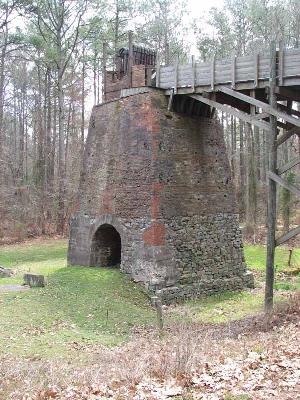
|
| Iron Furnace in Maryland |
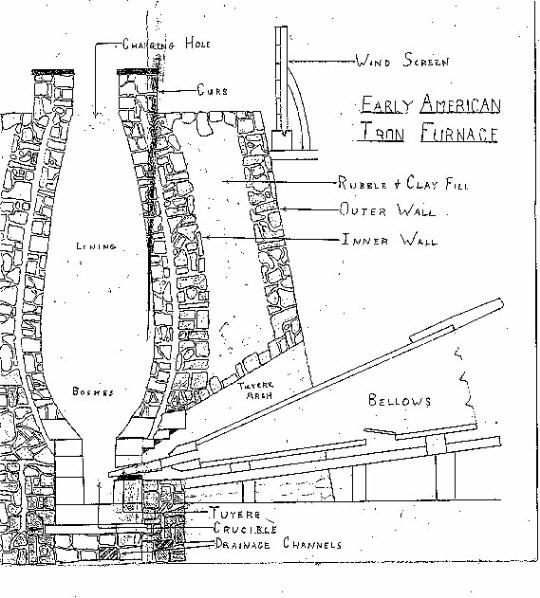
|
| Sketch of an early iron furnace |
About furnaces:
The exterior of the blast furnace was an immense structure that stood about 30-40 feet made out of huge
blocks of limestone from a local quarry. The blast furnace was constructed of limestone, and its hearth was built with sandstone.
The furnaces were located near hills in order for a transport bridge to be built between the furnace and the bridge house.
"When the Buena Vista, VA. furnace was in operation a building known as the bridge house ran from the hillock near the
furnace to the top of the stack. Through the bridge house were trundled the coal, flux, iron ore, all of which were dumped
into the mouth of the furnace" (Bradford 60).
Other local Iron Works:
Info taken from: The Iron Manufacturer's Guide to the Furnaces, Forges, and Rolling Mills of America
Published in 1859 by J.Peter Lesley
257. Amanda Charcoal Furnace, situated in Sullivan county Tennessee, on Little Sinking Creek, a half mile above Franklin
Furnace, was built in 1837 by Geo. Bushong who tore it down after the first blast, and built Franklin.
258. Franklin Cold-blast Charcoal Furnace, owned by
William Bushong, Holston Yalley P.O. Sullivan county Tennessee,
stands on Big Sinking Creek, twelve miles northwest of Elizabethton, two miles southwest of Paperville and four and a half
miles southeast of Bristol ; was built in 1838, is 8 feet across the bosh by 33 feet high, and makes about 150 tons of metal
per annum out of hematite ore from Sharp's and Crockett's banks four or five miles north.
** Frankin Furnace was reportedly destroyed by Union troops in 1863.
259. Holston or Welcher's Cold-blast Charcoal Furnace,
owned by "Welcher and Patton, managed by S. K. N. and J. A.
Patton, and situated in Sullivan county Tennessee, six miles south of the Bristol Railroad station, was built in 1838, is
8 1/2 feet across the bosh by 32 feet high, and made in twenty-three weeks of 1856 232 tons of metal out of hematite
ore from Sharp's bank six miles and Crockett's bank three and a half miles distant to the northeast.
260. 261. Two old Furnaces on Beaver Creek close to Beaver Creek Forge in Sullivan county Tennessee, were abandoned in
1837, and only the stacks remain.
**note: 1837 is the date George Bushong built Amanda Furnace on Little Sinking Creek. It is possible he was using
the materials from King's Iron Works, thus no traces of King's furnace remain in the Rooster Front area today. The
scrap metal drives of WW I & WW II may also be partly responsible.
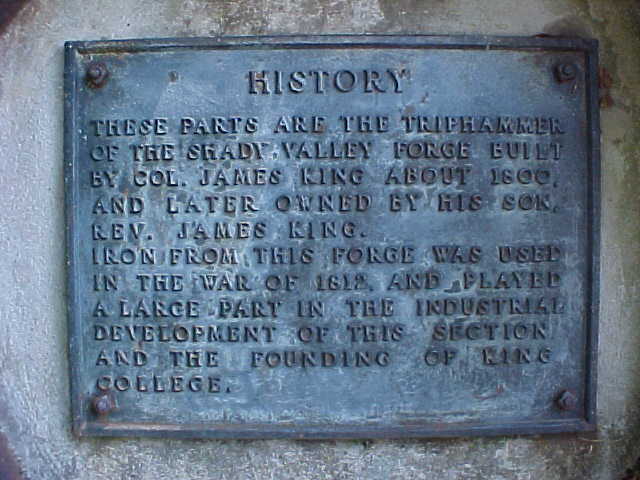
|
| Triphammer plaque |
Local Bloomeries & Forges :
347. King's Bloomary Forge,
situated on Beaver Dam creek, twenty-five miles northwest of Elizabethton, owned by James King Sen. managed by Jesse Cole
Jr. Shady P.O. Johnson county, built about 1821, has 2 bloomary fires and 1 hammer driven by water, and made in 1856 about
15 tons of bars.
*it is likely the triphammer displayed
at King College came from this Forge. However I have some questions about the accuracy of the text upon the plaque.
As noted above and published in1859, King's Shady Valley Forge wasn't constructed until about 1821, not
about 1800 - thus could not have been making anything during the War of 1812.
360. Waterloo Bloomary Forge,
situated on Beaver creek, three miles southwest of Paperville, and two miles southwest of Bristol, owned by Mrs. Cyrus King,
Bristol P.O. Sullivan county East Tennessee, built about 1830, has 2 bloomary fires and 1 hammer driven by water, and made
in 1855 about 18 tons of bars, since when it has done nothing.
361. Beaver Creek Upper Bloomary Forge, situated on Beaver creek,
three miles below Waterloo Forge, leased by Adam & Benjamin Shipley, Bristol, Sullivan county, built about 1800, has 2
bloomary fires and 1 hammer driven by water, and made in 1856 about 18 tons of bars from hematite ore from Sharp's bank, 10
miles east.
362. Beaver Creek Lower Bloomary
Forge, one mile below the last, is in all respects like it and was abandoned in 1855.
363. Old Bloomary Forge, situated
at the junction of Beaver creek and the south fork of Holston river, was abandoned in 1832, and is now all gone.
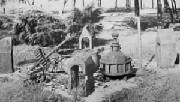
|
| remains of old forge-Laurel Bloomery, TN. |
Additional Information:
Associated with Col. King in
the operation of his iron furnace was William Blount, first territorial governor of Tennessee and the man for whom Blountville,
the county seat of Sullivan County, was named. A great part of the products of this furnace, iron and castings, found a market
down-state. They were hauled to Kingsport in wagons and from there were shipped down the river in boats. [ www.discoverkingsport.com/searchmap/spoden.shtml ]
By 1774 - King's Mill ,ie...Station, Fort,....a Colonial "stockaded fort,"
commanded by Lt. Gilbert Christian, figured prominently as a refuge from Indian attacks and as the storage place of flour"
for neighboring forts. Ammunition wagons, escorted by as many as 24
men, made the perilous journeys from King's Mill Fort through Moccasin Gap to the Clinch River Forts.
King's Mill Tavern-Sullivan County, located near where Kingsport stands
today, built about 1779; one of the earliest, if not indeed the first public ordinary ( Inn) west of the mountains.
1782 - John King, Sr. settled on his 400 acre Land Grant.
1789 - Pactolus Ironworks, built by Moses Cavitt, was purchased in 1795
by Walter King and John Sevier. By 1819 E. and E. Embree owned and expanded it to include forges, furnace, general store and
warehouses.
1790 - David Ross' Iron Furnace, "the Great Furnace." was built and operated
by Ross' agents. Ross, who always resided in Virginia, owned over 7,000 acres in Sullivan County and 1000s of acres in
Hawkins County.
1793 - David Ross purchased 5 acres of King's iron ore bank.
**(present day Orebank).
Between 1795 and 1811, the 3-story stone and frame Pactolus Boarding
House (ruins SS) was, in 1848, Col. Alfred E. Jackson's homeplace.
By 1796 - Jacob and Amanda Ross Myers , (operated Ross Furnace and other
enterprises), were living on "Woodlawn Plantation."
1802 - Wm. King, of Saltville, Virginia, purchased Lots No. 1 & 2
in the newly laid out town of Christianville. Here, his agents established King's Boat Yard which included warehouses, wharfs,
and counting, dwelling and boarding houses.
By 1819 - Pactolus Nail Factory, built and operated by Jonathan Wexler,
was owned by E. & E. Embree. On 29 Jan. 1828, Mariah King married
Elijah Embree.
1832 - in Pactolus Village, Pactolus Post Office's 1st postmaster was
Thomas Vincent.
By 1832 - Myers' Salt Petre Mine in a cave was in operation.
1848 - Jonathan Wexler, ironworker, blacksmith and planter, built a sawmill after
purchasing the "old Pactolus Furnace Tract."
**note: some of the preceding I have listed to allow one to see that indeed a
"community" did build itself around the early iron works.
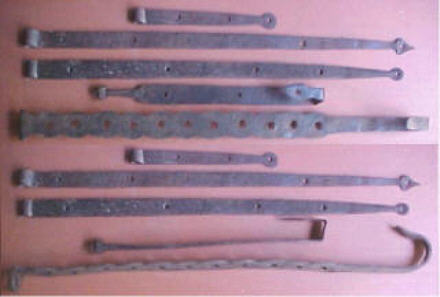
|
| Early Hand-forged Ironware |
A sampling of an 1860 local census shows us these interesting occupations:
1860 Census:: District 1...Holston Valley
1082 BUSHONG William 39 M Iron Manufactory 20000 6000 TN
Nancy
R. 28 F Housekeep TN
1207 PATON Joseph 48 M Iron Founder 100 ENG
Charles 17 M Day Labor
1055 OSBURN Solomon 54 M Furnace Hand 125 VA
1057 POOR John 36 M Furnace Hand 100 TN
1078 McCRARY Saml 44 M Moulder in Furnace 310 TN
1080 PHIPPS Alfred 59 M Moulder in Furnace 100 VA
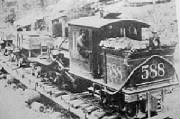
|
| iron ore train- Laurel Bloomery,TN. |
I have three things I'd like to see occur at Rooster Front Park:
1) Change the name to something more befitting of it's historical significance. If not for Col. King's Iron
Works, a lot of talented craftsmen and workers may not have been drawn to the Bristol area.
2) The erection of a "mock" furnace of limestone on the point between Beaver Creek & Steeles Creek.
3) The return of Col. King's log cabin to the Park.
While these may be mere pipe dreams at this time, they are ideas that I have now "put out there", and someday others
may take up the cause and these things may become a reality.
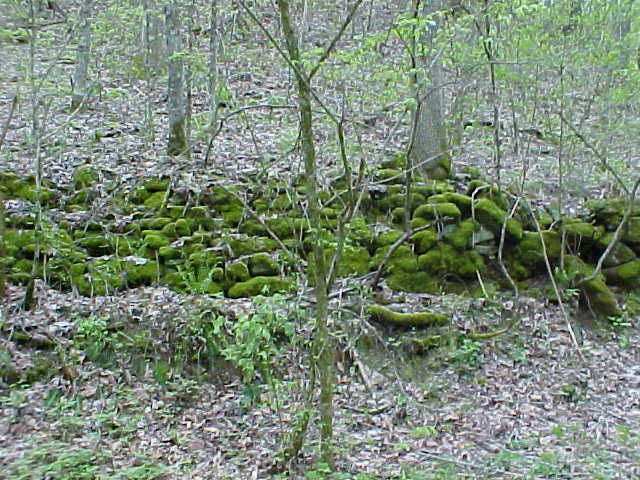
|
| Purpose of this retaining wall was ? when built? |
To sum things up...I have yet to find anything tangible but I learned a lot more than I anticipated. And - I am
still in pursuit of my original goal and more information about Colonel James King's Iron Works. There are many questions
that remain unasnwered and new ones posed to seek an answer to. So, if you espy me wandering the forests and hollows of Steele
Creek and Rooster Front Park , it's a sign I am either still seeking the unfound , or - I'm just roaming the woods
and streams I enjoyed as a child.
Update May 2009: It has been several months and I have yet to learn if the "quarry highwall" I discovered
is indeed a highwall.
In the meantime, the City began grading and clearing off another small park across the street (Vance Dr), from Rooster
Front Park. This was where Col. James King's log cabin office was when the Caldwells purchased it and relocated it to
the Deery Inn property in Blountville.
I was informed suggestions for naming this park would be taken and considered. I waited eagerly for the process to begin
and tried to come up with historically appropriate names to submit.
Last month I received a newsletter fom the Friends of Steeles Creek Park Nature Center and was surprised to see a name
had been chosen...ie..." SPECKLED HEN PARK."
Now I never really knew by whom, nor why the idiotic name of Rooster Front had been chosen, nor did I have any idea what
a Rooster Front actually was.
I imagine that in keeping with that name : Speckled Hen would be appropriate.
Its a shame a more befitting name wasn't chosen nor any input allowed by the Public.
I will continue to support Steeles Creek Park and the Nature Center, but this naming process has left a bad smell in
my nostrils.
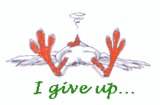
Comments:
"Well, I'm not surprised with the decision for the
name. Very few people in Bristol know the significance of the King's Iron Works or the King's themselves. You've
done some good research . . . . more than I have on this subject."
"I laughed out loud when I read your bit about the Speckled Hen Park. Maybe next they
can start a petition to rename the city of Bristol to "Evan Shelby's History Hidin' Chicken Ranch?"
"Speckled Hen Park? Wow! How idiotic. Makes sense, people don't give
two &*#% about history in this town."
"Anyway, your detailed history of the Upper East Tennessee Iron Industry was very informative,
intriguing and leaves me lusting for more! "
| Discard Speckled Hen name here: |
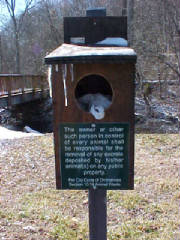
|
Update: 1Mar 2010...the powers that be have decided to not go with "Speckled Hen" as a name for the new area located
across from Rooster Front Park , which is the backdoor to Steele Creek Park. The new name is going to be Charlie Robinette
Park. Better than "Speckled Hen", but still not in keeping with that area's historical significance.
Additionally the City has placed new signs at Rooster Front @ Steele Creek Park...
1) notes that Rooster Front is part of Steele Creek and not a seperate entity.
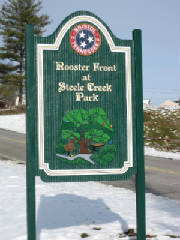
2) I guess the language on the dog poop disposal box may have offended some people, as they removed the old sign
and put up two new ones.

Next Page >>>>
|

